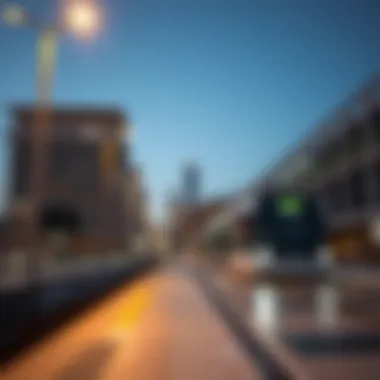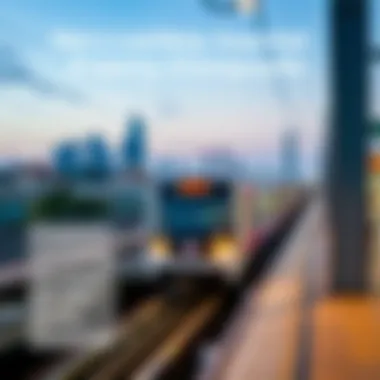The Last Metro: Essential for Dubai's Urban Mobility


Intro
The urban landscape of Dubai is ever-evolving, marked by constant progress and modernization. Central to this development is the public transportation system, particularly the last metro from Center Point. This segment is not only a pivotal aspect of commuting for countless residents and visitors but also significantly influences the city’s real estate dynamics. As commuters hop onto the metro towards the late hours, they aren't just reaching their destinations—they’re also shaping the economic fabric of this vibrant metropolis.
In this article, we will delve into various aspects surrounding the last metro’s role in urban mobility, including operational hours and commuter patterns. We'll also look at how the accessibility of the metro relates to real estate trends in Dubai. By understanding these connections, investors and residents can gain valuable insight into the socioeconomic implications at play. Let’s embark on a journey through the electric veins of Dubai—a journey illuminated by the last metro.
Understanding Dubai's Public Transportation System
Dubai's public transportation system is not just a network of buses and trains; it's a lifeline for the city's fast-paced, bustling population. As one of the fastest-growing cities globally, Dubai has established a sophisticated transportation framework that integrates various transit modes, including the metro, buses, taxis, and even water transport, into a cohesive whole. This article delves into the specifics of the metro, especially the significance of the last metro service, which plays a critical role in optimizing the urban mobility landscape of Dubai.
Overview of the Metro Network
The Dubai Metro began operations in 2009, becoming a crucial component of the transportation system. Stretching over 75 kilometers, it includes two main lines: the Red Line and the Green Line. The metro serves numerous high-density areas and key landmarks, such as the Burj Khalifa and Dubai Mall. The stations are designed to provide comfortable access for commuters, complete with ticketing machines, shops, and seating areas.
Significantly, the metro network has made good use of modern technology with its driverless trains. This innovation not only speeds up travel times but also enhances safety and efficiency. Each train is equipped with air conditioning to combat the hot climate and features real-time displays for passengers, providing updates on train schedules and routes. It’s clear that Dubai's metro network is built for both functionality and convenience, reflecting the city's ambitious vision for public transport.
Role of the Metro in Urban Mobility
The metro is more than just a means of transport; it plays a pivotal role in shaping the urban mobility of Dubai. With traffic congestion being a persistent problem in many metropolitan areas, the metro provides an alternative that reduces the dependency on personal vehicles. It’s especially pertinent in a city where rapid economic development has led to increased population density.
By linking various parts of the city efficiently, the metro allows for seamless transfers from one mode of transportation to another. This interconnectivity boosts accessibility and promotes a more sustainable urban environment. The metro station locations are often strategically selected to be near commercial and residential areas, which encourages the use of public transport rather than private vehicles. The socio-economic impact is significant as it helps alleviate the burden of traffic while fostering economic activities along the routes.
Importance of the Last Metro for Commuters
Among the various services provided by the metro, the last metro is of paramount importance for late-night workers, socialites, and those who benefit from Dubai’s vibrant nightlife. Operating until the early hours of the morning, it ensures that individuals can travel home without the hassle of securing alternative transport options, often costly or limited at that hour.
The last metro service preserves the fabric of community life in Dubai, offering people the freedom to pursue their jobs, hobbies, and social engagements without the looming stress of how to get home.
For many commuters, utilizing the last metro becomes a routine aspect of their work-life balance. The reliable transit option also acts as a lifebuoy for those without personal vehicles, linking them to their homes after long shifts or late gatherings. Furthermore, it provides a sense of safety in a city that prides itself on order and security.
In this way, understanding the public transportation system—specifically how the last metro fits into this puzzle—holds great relevance. It not only enlightens citizens and investors about the current transportation landscape but also illustrates the necessity of continual improvements to meet the needs of a diverse commuter base.
Last Metro from Center Point: Timings and Routes
The last metro from the Center Point station holds crucial significance in Dubai's public transportation network. This section dives into the operational hours, key routes, and various facets influencing commuter behaviors. The importance of understanding the timings and routes lies in the ability to seamlessly connect commuters to their destinations, ultimately shaping their daily routines and choices.
Operational Hours of the Last Metro
Commuters often rely on the last metro as a safety net, especially after a long day’s work or a fun night out. The operational hours are designed to accommodate late-night travelers, adding convenience to their journeys. Typically, the last metro service from Center Point operates until about 1 AM during weekdays, extending slightly later during weekends. This flexibility ensures access to various regions of Dubai at hours when many local transport services might have already ceased operations.
Additionally, the punctuality of these last trains can greatly influence commuter satisfaction. It’s essential for users to stay informed about these timings. Missing that last metro can lead to a scramble for alternative transportation methods, which can be less reliable or more expensive.
Key Routes and Destinations


The last metro line from Center Point connects to a variety of key locations that are central to the city’s nightlife, business districts, and cultural landmarks. Strategic destinations include:
- Downtown Dubai: With its sprawling shopping complexes and entertainment options, this area draws both tourists and residents alike.
- Dubai Marina: High-rise buildings and waterfront leisure spots are in constant demand among residents and visitors.
- Dubai Airport: The connection to the airport is critical for international travelers, making the metro a viable transport option for catching late flights.
Each of these destinations is not just a pin on a map; they represent hubs of activity enhanced by the last metro's accessibility. Users can easily calculate their journey times, making plans on the go more feasible.
Impact of Schedule on Commuter Behavior
The scheduling and availability of the last metro significantly shape commuter habits and preferences. Many people plan their nights around this schedule, knowing they can rely on it as a safe and cost-effective transport option. Here are some notable influences:
- Commuting Decisions: If individuals know the metro runs late, they might opt to stay out longer or attend evening events without the worry of transportation.
- Economic Choices: Opting for the last metro can be more economical compared to taxis or rideshares, allowing commuters to save money for leisure activities.
- Social Interactions: The presence of a reliable last metro promotes socializing, with friends often meeting close to metro stations for gatherings.
Commuting Patterns: Who Uses the Last Metro?
Understanding who utilizes the last metro from Center Point provides valuable insights into Dubai's public transport dynamics. Commuting patterns reveal not just the frequency of metro usage but also paint a broader picture of the city’s socioeconomic fabric. By dissecting these patterns, stakeholders—such as investors, realtors, and property managers—can better grasp the implications on property values and community planning.
Demographics of Last Metro Users
Analysis shows that the last metro attracts a diverse range of riders with distinct sociodemographic backgrounds. While every segment plays a role in utilizing public transit, specific groups stand out.
- Working Professionals: Many use the last metro to optimize their travel time after long workdays, especially those employed in sectors like technology and finance, concentrated in urban centers.
- Tourists and Visitors: The strategic location of the last metro makes it an ideal option for tourists returning from late-night excursions through Dubai's vibrant nightlife.
- Residents and Students: College students commuting late from evening classes or residents engaged in recreational activities are common sights, particularly on weekends.
This demographic richness highlights the metro's role in not merely facilitating movement but also in enriching the cultural and economic experiences within Dubai.
Commuter Profiles: Expats vs. Locals
A closer examination of commuter profiles reveals compelling contrasts between expats and locals. Expats often rely heavily on the last metro due to its efficiency and cost-effectiveness. They usually appreciate the seamless connectivity it offers, which extends to their workplaces and leisure venues.
- Expats: Many come from countries that prioritize public transportation, hence they naturally adapt to using the metro as their preferred method of transport. This group frequently comments on the ease of navigating Dubai's various districts using the metro.
- Locals: Emirati citizens, while also utilizing the last metro, may not rely on it as exclusively as expats. Their commuter choices can lean towards personal vehicles or taxis, primarily due to cultural preferences and status associated with car ownership.
However, it is noteworthy that many locals do embrace the metro for convenience while heading to crowded areas or events, revealing a slight convergence in commuter behavior.
Reasons for Choosing Public Transport
The decision to opt for public transportation, like the last metro, stems from several compelling reasons.
- Cost Efficiency: For many commuters, especially those in entry-level jobs or students, the metro offers an affordable means of transportation compared to private vehicles.
- Time-Saving: The last metro can significantly cut down travel time, especially during peak hours, where road congestion can skyrocket.
- Environmental Concerns: Growing awareness around sustainability nudges more commuters to prioritize public transport over fuel-dependent vehicles.
- Convenience: With regular scheduling and access to major hubs, the last metro simplifies the journey planning process for many users.
Understanding these elements allows for better service enhancements and a strategic approach to evolving commuter needs, making public transport more appealing.
The patterns of who uses the last metro not only help to identify the ambiguous needs of various demographics but also offer crucial insights that can inform future urban planning and real estate development strategies in Dubai.
The Real Estate Nexus: Metro Proximity and Property Values


The relationship between real estate and public transport is nothing new, but in a city like Dubai, the nexus seems almost symbiotic. The Last Metro running from Center Point plays a pivotal role in shaping property values and demand across various neighborhoods. As urban areas evolve and expand, understanding how proximity to metro stations influences real estate is crucial for investors, developers, and renters alike.
Zone in on the Last Metro and its impact on property values; it's not just about convenience. Accessibility can elevate a neighborhood’s profile, making it exceptionally attractive to both expats and locals who commute daily. With Dubai’s rapid growth, having a reliable transport system like the metro is paramount in determining the desirability of residential and commercial properties.
Increased Demand for Properties Near Metro Stops
As folks flock to Dubai's urban centers, the temptation to live close to metro stations grows. Properties situated near the Last Metro stop enjoy a significant uptick in demand, often leading to a competitive market among buyers. These prime locations attract young professionals reluctant to battle the notoriously congested traffic of the city.
- Benefits of Metro Proximity:
- Ease of Access: Ready access to public transportation reduces reliance on personal vehicles, saving both time and money for commuters.
- Vibrant Lifestyle: Areas near metro stations often see a mix of cafés, restaurants, and amenities that cater to the busy lifestyle of residents.
- Investment Potential: Properties close to the metro can become lucrative investments; their value tends to rise due to demand from future buyers or tenants.
Price Trends for Properties Close to the Metro
Comparing property prices in Dubai reveals interesting trends. Generally, homes located within a ten-minute walk of the metro tend to command a premium due to the attractive lifestyle they offer. According to recent data, properties adjacent to metro stops have exhibited price resilience even during economic downturns.
- Market Analysis:
- In the past few years, the price per square foot for properties near metro lines has risen more sharply than for those located farther away.
- Certain developments, especially luxury apartments, find their value significantly enhanced when bundled with metro accessibility.
"In Dubai, property values near metro stations are like rocks in a river—they never stay still. They’re always shifting, but they trend up when the commute is easy"
Investment Opportunities Around Centre Point
For savvy investors, the vicinity of the Centre Point metro station presents a golden opportunity. The growing interest in urban living environments propels real estate development projects. Understandably, not every enterprise will yield the same profit, but several factors elevate the appeal of investing near this metro hub.
- Potential Developments:
- Considerations for Investors:
- Upcoming residential projects specifically targeting millennials and working professionals prioritized for their proximity to the metro line.
- Retail spaces and mixed-use developments sprouting in the area reflect the demand for commerce and living integrated into urban planning.
- Conduct thorough market research to identify viable investment options.
- Understand the demographics of potential residents to tailor investments that meet their needs.
In summary, the interplay between the Last Metro and real estate values in Dubai is formidable. For stakeholders in the property market, recognizing these dynamics plays a vital role in making actionable investment decisions.
Socioeconomic Implications of Last Metro Timings
The last metro service departing from Center Point is more than just a mode of transport; it’s a lifeline for many and a significant factor in the overall socioeconomic landscape of Dubai. As urban mobility evolves, understanding the implications of these last metro timings has become crucial for stakeholders ranging from commuters to local businesses.
Effects on Work-Life Balance for Residents
In a city that never sleeps, where hustle and bustle reign supreme, the last metro represents a balancing act between work demands and personal life. For many residents, particularly those in the working class who rely on public transport, the last metro provides a crucial way to manage late-night shifts or obligations. Without it, some would find themselves navigating the complexities of finding alternative transport options at odd hours, which are often more expensive or less reliable.
- Commuters' experiences: Picture a nurse finishing a night shift, racing against the clock to catch the last ride home. The availability of this metro not only eases her journey but allows her to maintain her work commitment without sacrificing personal time with family.
- Impact on mental health: The stress of managing work-life dynamics can exacerbate feelings of anxiety among residents. The last metro facilitates a smoother transition from work to home life, ultimately contributing to improved mental well-being.


This aspect of urban mobility is vital; as individuals achieve better work-life balance, their satisfaction and productivity levels see an uptick.
Accessibility Issues for Various Demographics
Accessibility can be a tad tricky, especially for pockets of society that may feel this urban development hasn’t fully catered to their needs. While the metro is generally efficient, certain demographics face unique challenges that deserve attention.
- Elderly population: The last metro isn't always the easiest option for older residents. Issues such as limited mobility and lack of available assistance at late hours can deter them from using the service.
- Families with children: Families traveling with strollers and babies can find navigating crowded stations daunting, especially at night when the atmosphere may feel less safe.
- Low-income workers: Some low-income individuals might live in areas poorly connected to the metro lines, forcing them to rely on longer, multiple transport options, which may run late into the night.
Accessibility shouldn’t only be about infrastructure; it’s also about ensuring that every resident—regardless of age or socio-economic status—feels safe and able to make use of the metro system.
Influence on Local Businesses and Night Economy
Understanding the night economy’s rhythm is crucial for any city aiming to thrive, particularly in a pulsating city like Dubai. The last metro plays a pivotal role in supporting local businesses and entertainment venues, which often cater to late-night crowds.
- Extended hours for local businesses: When the last metro runs later, businesses can capitalize on the foot traffic generated by midnight shoppers and nighttime diners. Imagine restaurants offering special deals for post-midnight patrons, knowing their customers can rely on public transport to get home safely.
- Vibrancy in nightlife: The convenience of knowing that a metro is available until the wee hours encourages residents to indulge in the nightlife, thereby generating a continuous flow between various sectors—hospitality, retail, and cultural events all flourish in dynamic environments.
- Economic growth: Well-placed businesses that strategically cater to metro schedules can see significant returns on investment, thereby positively impacting local economies.
Through this lens, it’s clear that the last metro acts as a catalyst in enhancing not only individual experiences but the broader economic tapestry of the city.
Understanding these nuances is essential for investors, property managers, and city planners as they work toward creating a more interconnected and vibrant Dubai.
Future of the Metro System in Dubai
The future of Dubai's metro system is a topic gaining considerable traction amongst urban planners, investors, and real estate enthusiasts alike. As the city continues to expand, so does the demand for efficient public transport. The metro system stands as a linchpin in this growth, linking various neighborhoods and offering a sustainable mode of transport. As we look ahead, several key elements will shape the evolution of this crucial transit system.
Proposed Changes and Expansions
In recent years, discussions regarding proposed changes and expanions to the metro system have become increasingly pertinent. Planners have hinted at extending existing lines, which could potentially connect to newer suburbs that are currently underserved. For instance, there’s talk about extending the red line further into the sprawling developments in Dubailand, enhancing accessibility and commuting ease for residents.
Additionally, new stations are being considered to cater to emerging areas such as Dubai South and the futuristic city of Mohammed bin Rashid City. These expansions are not just about reaching distant locales; they signify an opportunity to boost the local economy. More access points can lead to increased foot traffic, benefiting local businesses and real estate values.
"Developers are keen to align projects with proposed metro expansions to maximize property appeal."
Role of Technology in Modernizing Transport
As we step deeper into the digital age, technology plays a pivotal role in modernizing transport systems, including the metro. From smart ticketing solutions to real-time tracking apps, the integration of technology aims to enhance user experience. Riders can expect to see developments like contactless travel cards and mobile ticketing options, which could simplify the journey.
Moreover, the introduction of AI analytics could provide insights into travel patterns, smoothing out peak hour congestion and ensuring that service meets demand. Digital displays at stations revealing train schedules and platform updates in real-time are becoming increasingly common, allowing commuters to plan their journeys better.
Furthermore, infrastructure upgrades like automated trains might not be far off. These changes could not only improve efficiency but also safety, contributing to Dubai's reputation as a world-class city.
Long-Term Outlook for Urban Mobility
Looking forward, the long-term outlook for urban mobility in Dubai suggests a shift towards more sustainable transport solutions. The idea is to create a comprehensive network that supports various modes of transport, not just the metro. This includes enhancing the integration between metro services, buses, and even cycling lanes, encouraging a shift from personal vehicles to public transport.
Sustainability will likely take center stage in upcoming projects. With the global focus on reducing carbon footprints, Dubai's metro system is expected to adopt greener technologies. This might involve energy-efficient trains and the utilization of renewable sources, like solar panels installed at stations.
The alignment of the metro with urban development plans is crucial; it will not only influence where businesses decide to plant their roots but also dictate residential trends. Investors who keep their eyes on the evolving landscape will find lucrative opportunities emerging.
Ultimately, the future of the metro system in Dubai is not just about transportation but about shaping the very essence of how the city functions and evolves, making it a bedrock for upcoming generations.















